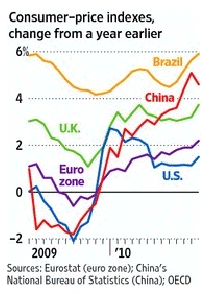 Well, for most Americans, the cost of living is indeed rising. Prices for basic human needs such as food, clothing, heat and transportation have increased dramatically over the last two years. The average price for regular gasoline in the US is $3.12 per gallon, the highest level since July 2008 and 62 cents/gal higher than the peak price during the 1974 oil embargo. General prices, as measured by CPI growth, are ticking up worldwide. Food prices are exploding here and around the world. Although drought conditions of 2010 contributed to the spike in grain prices, the major cause is government intervention.
Well, for most Americans, the cost of living is indeed rising. Prices for basic human needs such as food, clothing, heat and transportation have increased dramatically over the last two years. The average price for regular gasoline in the US is $3.12 per gallon, the highest level since July 2008 and 62 cents/gal higher than the peak price during the 1974 oil embargo. General prices, as measured by CPI growth, are ticking up worldwide. Food prices are exploding here and around the world. Although drought conditions of 2010 contributed to the spike in grain prices, the major cause is government intervention.
Government has attempted to control prices using monetary policy, government subsidies for selected industries and emergency executive order. The Fed tries to control inflation (and more recently, unemployment) by easing or tightening interest rates. The Fed has cut rates to near zero, after lowering rates continually since 2007. The easy money policy is designed to stimulate economic activity and "manage" inflation to acceptable (low) levels. Congress has enacted a series of farm bills since 1965 to subsidize US agribusiness. The current farm bill, the Food and Conservation and Energy Act of 2008, provided $288 Billon in direct subsidies, including increased allocations for biofuels (ethanol). Presidents Roosevelt, Truman, Nixon and Carter all implemented direct price or price-wage controls to disastrous affect (I remember waiting in line for my ration of 8 gallons of gas on odd calendar days in 1974).
History has shown that price controls, however implemented, simply do not work. Fixing prices below natural market levels has been tried since ancient Rome. In the French Revolution, the "Law of the Maximum" sent offenders to the guillotine. The Soviet Union's central planners controlled all prices and also created a vigorous black market. In the US, World War I commissions and later during WWII, FDR's Office of Price Administration set prices in broad markets. The result was severe shortages in many staples, including meat. Although controls were eventually lifted for most products after the war, control of meat prices continued. In 1946, Truman nearly sent federal troops to Chicago to free up meat supplies from packing-house "hoarders".
The fundamental cause of general inflation is excessively expansive monetary policy, that is, printing money at a rate higher than the growth in GDP. "Excess money" devalues the medium of exchange, and drives prices up for needed products and services. The rise in commodity prices over the last two years is a good example. Since the Fed added $1.4 Trillion to the money supply two years ago, commodity prices have skyrocketed 80% from 2009 levels. Commodity price increases flow to producer prices and eventually into consumer prices. The Consumer Price Index (CPI) is compiled and reported by the Bureau of Labor Statistics.

The CPI, as published, is deceptive. It does not reflect the true inflation rate observed by most individual consumers. This is because the published numbers are composed of certain components, assumed to be representative of the average consumer's "basket of goods". This can vary significantly from, for example, fuel costs differ greatly for the person who drives a super-duty truck for work every day compared to the urban office worker who relies exclusively on public transportation. People tend to have differing diets as well, as a result of tradition, religion or culture. So the common basket of goods is a myth.
We can point to real food price increases by a few common examples: at the wholesale level, whole chickens cost 69c/lb in Dec 2006, and 85c/lb Dec 2010, according to USDA data; Sugar cost 11.7c/lb in Dec 2006 and 31c/lb in Dec 2010. Where I live, a 3 1/4 lb whole chicken sells today for $8.
In Dec 2006, coffee cost $1.29/lb wholesale and climbed to $2.37/lb wholesale by Dec 2010. I paid $3.25/lb this week for coffee at my local grocery.
Since I need to buy food, heat my house and drive my car, how can I protect myself from inflation? For certain, I won't rely on the Federal government. I will rely on my own good judgment.
I will invest some of my discretionary income in gold and silver as a hedge against inflation, which I expect will accelerate in the near future and further devalue the paper dollars I earn. With hard assets in my portfolio, I spread my risk. Gold has never been worth zero. It has quadrupled in value over the last ten years. I will also stay invested in gold and silver stocks. Although these can be more volatile than the metals, the inflation premium is discounted the market price, a distinct advantage over fixed income securities, such US Treasury notes.

No comments:
Post a Comment